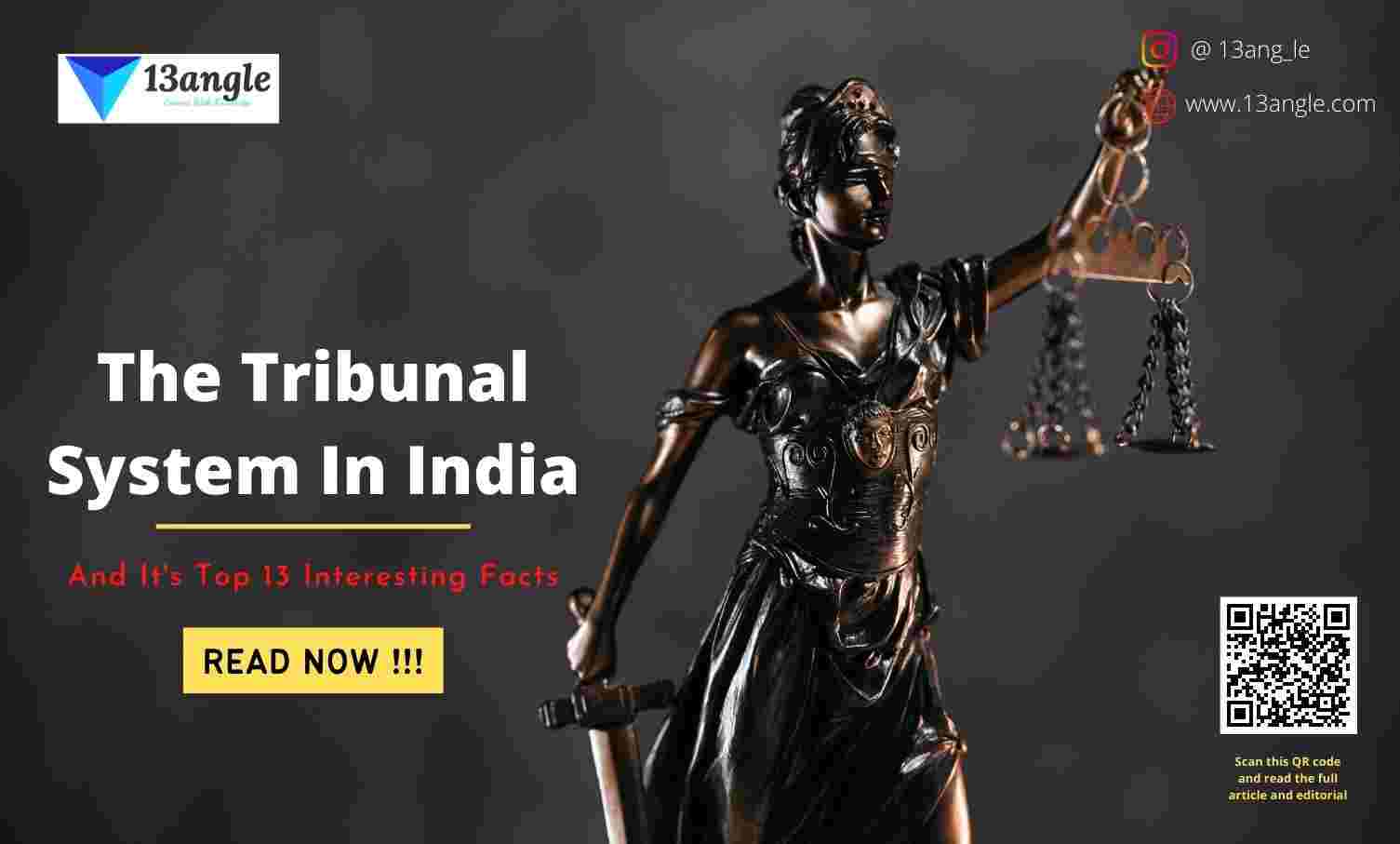
Introduction
In the annals of ancient mythology and epic tales, few characters have captured the imagination of readers and scholars as intensely as Ravana, the enigmatic king of Lanka. Known for his unparalleled power, intellect, and ten heads, Ravana stands as a figure shrouded in complexities and motivations that continue to intrigue and fascinate us to this day.
Step into the captivating world of Ravana’s kingdom as we embark on a journey to explore the splendors that thrived under his rule. From the magnificent architecture and advanced engineering marvels to the rich cultural heritage and prosperity that pervaded the land, Ravana’s kingdom was a testament to his prowess as a ruler and visionary leader. Join us as we unveil the hidden gems of this extraordinary empire, delving into the opulent palaces, sprawling gardens, and awe-inspiring temples that formed the backdrop of Ravana’s reign.
Ravana’s character, often portrayed as a formidable antagonist, transcends the boundaries of a conventional villain. A deep dive into his persona reveals a multifaceted individual driven by intricate motivations and inner conflicts. Through a comprehensive analysis of Ravana’s character, we seek to understand the forces that shaped him and the choices he made. By shedding light on his strengths, weaknesses, and the choices that propelled him, we aim to uncover the human side of this mythological figure and appreciate the layers of his persona.
The clash between Rama and Ravana, two legendary figures of Indian mythology, has captivated generations with its epic proportions. In a comparative study of these iconic characters, we delve into the similarities and differences that define their narratives. Explore the contrasting ideologies, contrasting paths, and ethical dilemmas faced by both Rama and Ravana, as they stand as archetypes representing the eternal battle between good and evil. Through this exploration, we unravel the nuances of their characters and the profound impact their choices had on the world around them.
Ravana’s ten heads have long been a subject of intrigue and symbolism. Beyond their literal interpretation, these heads have been viewed as a metaphor for the complexities of human nature. Join us as we delve into the varied interpretations and symbolisms surrounding Ravana’s ten heads, seeking to uncover the deeper meaning behind this mythical trait and its relevance in our understanding of the human psyche.
The abduction of Sita and Rama’s subsequent exile marked a pivotal turning point in the epic tale of Ramayana. Analyzing the events that led to this dramatic encounter, we unravel the motivations and consequences that shaped the narrative. Explore the themes of loyalty, sacrifice, and honor as we delve into the complex web of relationships and circumstances that culminated in one of the most significant confrontations in ancient literature.
The battle between Rama and Ravana, a clash of titans, reverberates with timeless significance. As we unravel the layers of this epic duel, we explore the profound symbolism, strategic maneuvers, and moral dilemmas embedded within it. Witness the culmination of divine intervention, valor, and destiny as these legendary warriors vie for supremacy on the battlefield. Through an examination of this epic encounter, we gain a deeper understanding of the cultural, moral, and philosophical lessons embedded within its core.
In the aftermath of his defeat, Ravana’s story takes an unexpected turn. Reflect on the consequences of his actions and the path to redemption that unfolds. Explore the moral complexities of his character and the potential for growth and transformation. As we contemplate the lessons derived from Ravana’s defeat and redemption, we delve into the profound themes of accountability, forgiveness, and the power of second chances.
Ravana’s enduring legacy extends beyond the realms of ancient mythology into the realms of literature and art. Examine the diverse depictions and adaptations of the king in different cultural contexts. From ancient scriptures to contemporary literature, paintings, and sculptures, Ravana’s presence resonates across time and space. Explore the artistic interpretations and cultural significance of his character, as we navigate the vast tapestry of human creativity inspired by this enigmatic figure.
Finally, let us draw inspiration from Ravana’s story, for it offers valuable insights into morality, ambition, and the power of redemption. Analyze the moral dilemmas faced by the characters, the consequences of their actions, and the potential for growth and redemption that exists within us all. Through the lens of Ravana’s story, we discover timeless lessons that resonate with our own experiences, reminding us of the complexities of human nature and the transformative power of choices.
Join us on this enthralling exploration of Ravana’s kingdom and his captivating story. From the splendors of his empire to the depths of his character, we unravel the threads that bind this mythical figure to our collective consciousness. Embark on this journey of discovery and reflection and emerge with a newfound appreciation for the intricacies of Ravana’s tale and the profound wisdom it holds for us all.
Ravana's Kingdom: Unveiling The Splendors Of Lanka Under Ravana's Rule

Lanka, the kingdom ruled by Ravana, is a land shrouded in mystery and enchantment. It was a realm renowned for its opulence, architectural marvels, and advanced civilization, flourishing under the rule of the roaring king. In this article, we embark on a captivating journey to explore the splendid kingdom of Lanka, shedding light on its captivating features and the remarkable legacy left behind by Ravana’s reign.
Lanka, often referred to as the “City of Gold,” emanated a mesmerizing aura with its breathtaking architecture and radiant splendor. The entire city was adorned with gold-plated palaces, temples, and structures that shimmered under the sun, captivating the imagination of all who beheld them. The magnificence of Lanka’s golden city became a symbol of Ravana’s immense wealth, power, and artistic sensibilities.
The kingdom boasted majestic palaces, each a testament to Ravana’s exquisite taste and grandeur. Among these, the most renowned was the Pushpaka Palace, an awe-inspiring structure that served as Ravana’s abode. The palace, constructed entirely of crystal and adorned with precious gems, featured enchanting gardens, intricate carvings, and sprawling courtyards that added to its allure and grandeur.
Lanka prided itself on its lush gardens and magnificent botanical wonders, designed to captivate the senses and instill a sense of tranquility. The Ashoka Vatika, Ravana’s private garden, stood as a paradise of blossoming flowers, rare plants, and cascading waterfalls. It was within this ethereal garden that Sita, the wife of Lord Rama, was held captive, adding an element of tragedy to the kingdom’s beauty.
The architectural marvels of Lanka were a testament to the advanced engineering skills of its inhabitants. The kingdom boasted towering temples, magnificent fortresses, and sprawling pavilions that showcased the architectural prowess of its builders. Among these structures, the Trikuta Mountain stood as the most notable, serving as an enormous mountain fortress that acted as the central seat of power for Ravana. It was impregnable, fortified with intricate defences, and guarded by a formidable army.
Technological advancements were a hallmark of Lanka under Ravana’s rule, surpassing the era in which it existed. The kingdom boasted advanced irrigation systems, underground tunnels, and a sophisticated network of roads that enhanced connectivity and facilitated trade. The Pushpaka Vimana, Ravana’s celestial flying chariot, exemplified the kingdom’s mastery over aviation and transportation, leaving contemporaries in awe of its ingenuity.
Lanka thrived as a center of art, literature, and culture, fostering an environment where scholars, poets, and artists from various realms converged to exchange knowledge and ideas. The city’s cultural landscape was enriched with music, dance, drama, and philosophical discourses, creating a vibrant and intellectual atmosphere. Lanka became a hub of intellectual and creative pursuits, a testament to Ravana’s patronage of the arts.
Ravana’s rule was marked by social harmony and prosperity within the kingdom. The citizens of Lanka enjoyed a high standard of living, with access to education, healthcare, and a well-organized governance system. Ravana’s administration ensured the equitable distribution of resources and established a just legal framework, which contributed to the overall well-being and contentment of the people.
The kingdom of Lanka, under the rule of Ravana, stands as a testament to the splendors of a bygone era. Its golden city, magnificent palaces, advanced civilization, and flourishing cultural landscape reflected the power, wealth, and artistic sensibilities of the roaring king. As we delve into the legacy of Ravana’s reign, we discover a realm that embraced grandeur, technological advancements, and cultural flourishing. Lanka remains an enduring symbol of a kingdom that thrived under the awe-inspiring rule of one of Hindu mythology’s most captivating and enigmatic figures.
Ravana's Character Analysis: Understanding The Complexities And Motivations Of The King

Ravana, the roaring king of Lanka, is a complex and multifaceted character in Hindu mythology. Often depicted as a formidable antagonist, his motivations and actions go beyond simple notions of good and evil.
At the core of Ravana’s character lies an insatiable ambition and an unquenchable thirst for power. From an early age, Ravana’s exceptional intellect and natural abilities fueled his desire to conquer and rule. His relentless pursuit of supremacy led him to wage wars, defeat powerful adversaries, and establish himself as the sovereign ruler of Lanka. Ravana’s ambition, although driven by ego, showcases his unwavering determination and formidable capabilities.
Ravana’s character is marked by his unparalleled intellect and vast knowledge. As the son of the sage Vishrava, he was raised in an environment that fostered intellectual growth and spiritual wisdom. His mastery over diverse subjects, including scriptures, warfare, magic, and religious rituals, showcases his intellectual prowess. Ravana’s intellectual brilliance not only contributed to his rise but also adds depth to his character, highlighting his multifaceted nature.
Despite being portrayed as a demon king, Ravana’s character defies simplistic moral categorizations. His actions often blur the lines between right and wrong, raising complex ethical dilemmas. For instance, his abduction of Sita, the wife of Lord Rama, is a morally ambiguous act. While it demonstrates his possessiveness and desire for vengeance, it also reveals his love for beauty and his ability to make bold decisions. Ravana’s character challenges conventional notions of morality, making him a captivating figure for analysis.
Beneath Ravana’s fierce exterior lies a deep spiritual inclination and devotion. His unwavering dedication to Lord Shiva showcases his religious fervor and his desire to seek divine favor. Ravana’s intense penance and austerities demonstrate his spiritual depth and his pursuit of transcendence. This aspect of his character adds a layer of complexity, as it reflects his yearning for spiritual fulfillment amidst his material ambitions.
Ravana’s character is not devoid of emotions; rather, it is marked by a range of complex and conflicting emotions. Despite his power and conquests, he remains plagued by personal tragedies and emotional vulnerabilities. His unrequited love for Sita and the consequences of his actions reveal his capacity for deep emotions and the tragic flaws that ultimately lead to his downfall. Ravana’s character demonstrates the interplay between power, emotions, and the complexities of the human psyche.
Ravana’s character is rich in symbolism and can be subject to various psychological interpretations. Some view him as a representation of human desires, ego, and the shadow self. His ten heads, often interpreted as symbolizing the ten senses or human vices, add depth to his psychological complexity. Exploring the symbolic and psychological dimensions of Ravana’s character offers a deeper understanding of his motivations and inner struggles.
Ravana’s character is a study in complexity, with motivations that go beyond conventional definitions of good and evil. His ambition, intellectual brilliance, moral ambiguity, spiritual depth, and emotional complexities create a multifaceted persona that challenges our perceptions. Understanding Ravana’s character requires delving into the depths of his psyche, exploring the interplay of power, desire, morality, and the intricacies of human nature. Through this exploration, we can gain insight into the enigmatic and captivating figure that is Ravana, the roaring king of Lanka.
Rama And Ravana: A Clash Of Titans - A Comparative Study Of The Two Iconic Characters
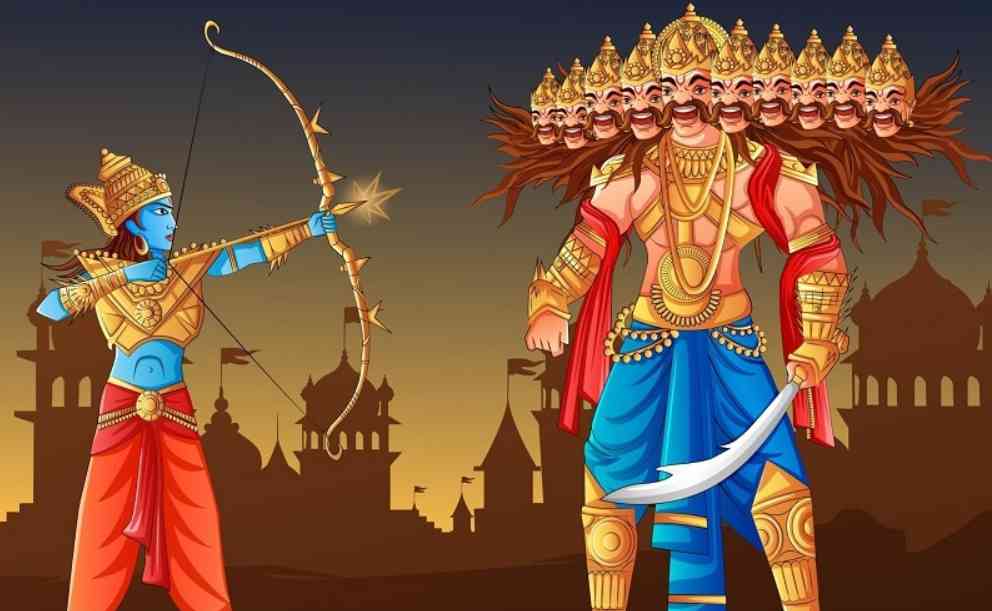
The epic tale of the Ramayana in Hindu mythology revolves around the dramatic encounter between two iconic characters: Rama, the righteous prince of Ayodhya, and Ravana, the roaring king of Lanka. The story of the Ramayana is not merely a narrative of their individual exploits, but it also serves as a profound exploration of dharma (duty), morality, and the eternal struggle between good and evil. Through a comparative study of Rama and Ravana, one can gain insights into their character traits, motivations, and the lessons they impart.
Rama, the seventh avatar of Lord Vishnu, is the embodiment of virtue, righteousness, and ideal kingship. He exemplifies noble qualities such as integrity, compassion, humility, and unwavering devotion to duty. Rama’s adherence to dharma and his steadfastness in upholding truth and justice make him a symbol of moral rectitude and an inspiration for humanity. His character embodies the virtues that are highly regarded in Hindu philosophy and serves as a role model for individuals seeking to live righteous and virtuous life.
On the other hand, Ravana, the antagonist of the Ramayana, is a complex character that challenges simplistic notions of good and evil. Despite his demonic nature and tyrannical rule, Ravana is portrayed as a highly intelligent, charismatic, and multi-talented personality. His profound knowledge, intellectual brilliance, and exceptional powers make him a formidable adversary to Rama. Ravana’s character is not one-dimensional; it contains depth and complexity, which adds to the richness of the narrative.
Rama’s motivations are driven by his sense of duty, righteousness, and love for his wife, Sita. He embarks on the mission to rescue Sita from Ravana’s clutches, motivated by his unwavering devotion and commitment to protect Dharma. Rama’s journey is propelled by his determination to restore order, defeat evil, and fulfill his responsibilities as a prince and a husband.
On the other hand, Ravana’s motivations are complex and multi-layered. His desire for power, fame, and dominance fuels his actions. Ravana’s ego and ambition drive him to seek supremacy over the three worlds, resulting in his confrontations with gods and his abduction of Sita. While Ravana’s motivations are rooted in personal gain, his character also exhibits depth, intellect, and a certain tragic complexity. Despite his flaws, Ravana is not portrayed as a one-dimensional evil character, but rather as a complex being with strengths and weaknesses.
Rama embodies numerous virtues that make him an ideal hero. His unwavering commitment to truth, righteousness, and his ability to make sacrifices for the greater good are emblematic of his noble character. Rama’s humility, loyalty, and respect for his allies and subjects further reinforce his virtuous nature. He is an exemplar of ideal kingship and serves as a paragon of virtue.
In contrast, Ravana’s character is marked by his tragic flaws. His unchecked pride, arrogance, and lust for power cloud his judgment and lead to his downfall. However, beneath his flaws, Ravana possesses admirable qualities such as bravery, strategic brilliance, and devotion to Lord Shiva. The interplay of virtues and flaws in Ravana’s character adds depth and complexity to his portrayal, making him a more nuanced and compelling figure in the epic.
Rama and Ravana, as characters, represent archetypal forces that exist within human nature. Rama embodies the ideal of a just and virtuous ruler, symbolizing the triumph of righteousness over evil. He represents the embodiment of dharma and serves as a moral compass for humanity. Ravana, on the other hand, represents the shadow aspects of human nature. His character symbolizes the consequences of unchecked desires, ego, and the allure of power. Ravana’s persona highlights the internal struggles between good and evil within individuals, serving as a cautionary tale of the dangers of succumbing to one’s baser instincts.
The clash between Rama and Ravana in the epic Ramayana is a profound exploration of contrasting archetypes and moral dilemmas. Rama’s unwavering virtue, righteousness, and adherence to dharma stand in stark contrast to Ravana’s complex character, driven by ambition, pride, and flawed desires. The comparative study of Rama and Ravana serves as a reminder of the eternal struggle between good and evil within us, offering valuable insights into the human condition and the choices we make in our own lives. The tale of the Ramayana continues to inspire and resonate with people across generations, imparting timeless wisdom and moral lessons that remain relevant in today’s world.
Ravana's Ten Heads: Symbolism And Interpretations Of The Mythical Trait
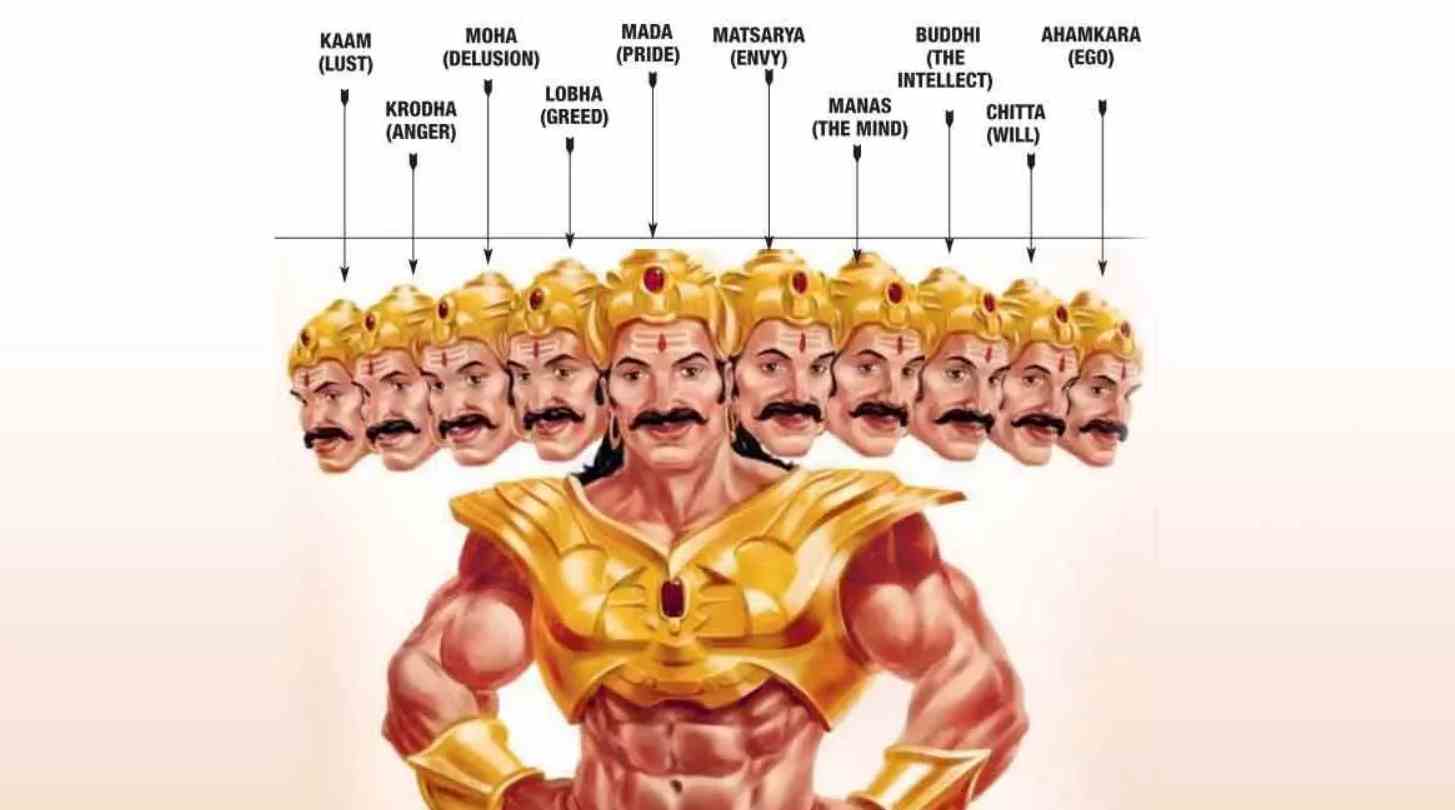
In Hinduism, the character of Ravana, the roaring king of Lanka, is known for his distinctive attribute of having ten heads. This intriguing feature of Ravana has captivated scholars, artists, and spiritual enthusiasts for centuries. The ten heads of Ravana hold deep symbolism and offer various interpretations, shedding light on the complexity of his character and the human psyche.
One interpretation of Ravana’s ten heads lies in his exceptional intellect and vast knowledge. Each head represents a specific domain of knowledge, signifying his mastery over various fields such as scriptures, warfare, magic, and music. Ravana’s ten heads symbolize his intellectual brilliance, multifaceted talents, and insatiable thirst for knowledge. This portrayal highlights Ravana as a highly learned and knowledgeable individual, whose intellectual prowess sets him apart from ordinary beings.
Another interpretation associates Ravana’s ten heads with the ten senses, encompassing both external and internal senses. Each head represents one of the senses, including sight, hearing, smell, taste, and touch, as well as the internal faculties of mind, ego, intellect, and consciousness. In this context, Ravana’s ten heads symbolize his profound engagement with the sensory world, his attachment to worldly desires, and the challenges posed by sensory temptations. It reflects the human struggle to transcend the pull of the senses and attain higher spiritual states.
Ravana’s ten heads are sometimes interpreted as representing the ten vices or negative traits that afflict human beings. These vices include lust, anger, greed, pride, jealousy, attachment, selfishness, arrogance, ignorance, and deceit. Each head symbolizes one of these vices, portraying Ravana as a character deeply entangled in the web of human flaws and moral weaknesses. This interpretation serves as a reminder of the eternal battle between virtue and vice, and the inherent capacity within humans to succumb to negative tendencies.
The ten heads of Ravana also signify the intricate layers of his personality. Each head represents a different aspect of his character, highlighting his multidimensionality. Ravana is depicted as a complex individual with conflicting emotions, intellect, ambition, and desires. The ten heads serve as a metaphorical portrayal of the complexity and depth of his character. This interpretation reminds us of the multifaceted nature of human beings, with various facets and dimensions that shape their identities.
Ravana’s ten heads are often associated with his power and dominion. The multiple heads represent his sovereignty over the ten directions, symbolizing his vast empire and influence that extended in all directions. They serve as a visual depiction of his authority, intimidating his enemies and asserting his rule. This interpretation highlights the grandeur and supremacy of Ravana, emphasizing his position as a formidable king and ruler.
In some interpretations, Ravana’s ten heads carry spiritual symbolism. They represent the ten stages of spiritual progress or the ten levels of consciousness. Each head symbolizes a stage of spiritual evolution, from base consciousness to higher states of enlightenment. Ravana’s portrayal with ten heads signifies his potential for spiritual growth and the transformative journey he could undertake. It signifies the inherent capacity of individuals to evolve spiritually and ascend through various stages of consciousness.
The ten heads of Ravana in Hindu mythology carry profound symbolism and offer diverse interpretations. From representing intellectual prowess and mastery of knowledge to symbolizing the senses, vices, complexity of character, power, and spiritual stages, they add layers of meaning to Ravana’s persona. The significance of the ten heads extends beyond the Ramayana, serving as a metaphor for the complexities of the human condition and the inherent struggles between virtue and vice. Exploring the symbolism and interpretations of Ravana’s ten heads deepens our understanding of his character and offers insights into the broader aspects of human nature and spiritual growth.a
Rama's Exile And The Abduction Of Sita: Examining The Events That Led To The Dramatic Encounter
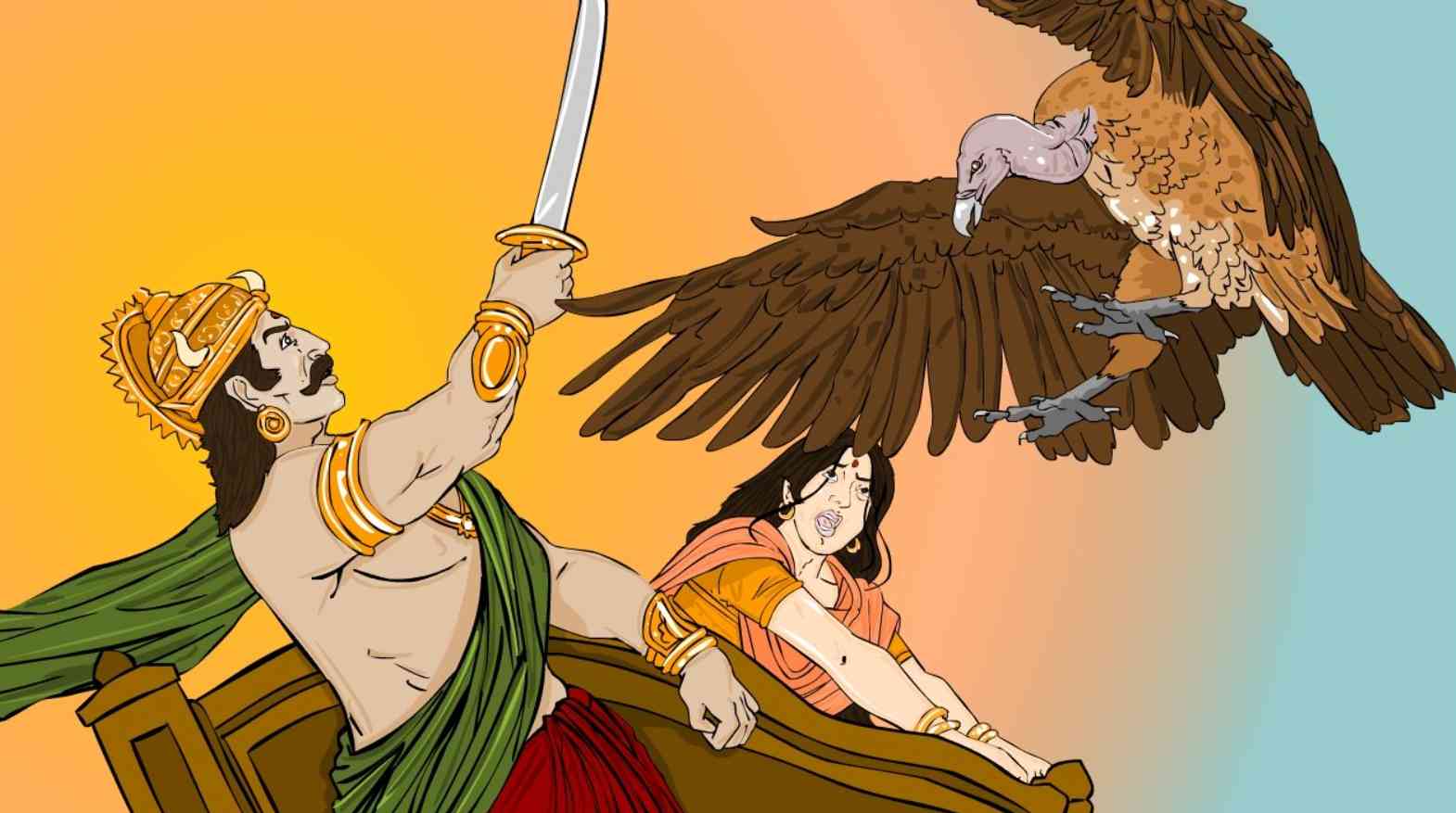
The epic Ramayana is a legendary tale that has captivated audiences for centuries with its rich narrative and timeless themes. At the heart of this epic is the abduction of Sita, the beloved wife of Rama, the righteous prince of Ayodhya.
The story of Ramayana begins with a divine boon granted to Queen Kaikeyi by King Dasharatha, Rama’s father. As a result of this boon, Dasharatha promised to fulfill any two wishes Kaikeyi desired. Taking advantage of this opportunity, Kaikeyi chose to secure the throne for her own son, Bharata, and send Rama into exile for a period of fourteen years. This sudden and unjust demand came as a shock to Rama, who had always been an obedient and dutiful son.
Despite the injustice of his exile, Rama willingly accepted the decree, upholding his unwavering commitment to honor his father’s word and maintain the integrity of dharma, which encompasses duty, righteousness, and moral order. Rama’s willingness to sacrifice his own desires for the greater good and his devotion to upholding dharma endeared him to the hearts of the people of Ayodhya. He became a revered figure, embodying the ideals of virtue and righteousness.
Sita, Rama’s devoted wife, chose to accompany him during his exile, defying societal norms and demonstrating her unconditional love and unwavering support. Her decision symbolizes the strength of their bond and her own commitment to dharma and spousal duty. Together, Rama and Sita embarked on a challenging journey through forests, encountering sages, demons, and divine beings, testing their faith and resilience.
During their exile, Rama, Sita, and Rama’s loyal brother, Lakshmana, encountered Surpanakha, the sister of Ravana, the powerful and roaring king of Lanka. Surpanakha, captivated by Rama’s beauty, proposed marriage to him. However, Rama politely rejected her advances, stating his unwavering devotion to Sita. Surpanakha, consumed by jealousy and rage, sought vengeance by attacking Sita. In response, Lakshmana intervened and, in the heat of the moment, severed Surpanakha’s nose and ears.
Surpanakha’s disfigurement triggered Ravana’s desire for revenge and his fascination with Sita’s unparalleled beauty. Ravana, known for his charisma and power, devised a cunning plan to abduct Sita, enlisting the help of his trusted demon Maricha. Disguised as a golden deer, Maricha caught Sita’s attention, luring Rama and Lakshmana away from her. In their absence, Ravana seized the opportunity and abducted Sita, leaving her distraught and helpless.
Upon discovering Sita’s abduction, Rama was consumed by grief and anguish. Determined to rescue his beloved wife, he embarked on a desperate search, traversing treacherous terrains and forming alliances with various beings along the way. One of the most prominent allies he encountered was Hanuman, the monkey king, and his army of Vanaras. With their unwavering loyalty and incredible strength, Rama eventually reached Lanka, the kingdom of Ravana prepared to confront the demon king and rescue Sita.
The events leading to Rama’s exile and the subsequent abduction of Sita in the Ramayana are a testament to the complexities of human emotions, the challenges posed by destiny, and the triumph of love and righteousness. Rama’s acceptance of his exile despite its unfairness, Sita’s unwavering devotion and sacrifice, and Ravana’s deceitful plot set the stage for the dramatic encounter between Rama and Ravana. This pivotal moment in the epic showcases the clash between good and evil, the power of unwavering love, and the steadfast commitment to upholding dharma.
The story of Ramayana continues to resonate with audiences of all generations, transcending time and cultural boundaries. It serves as a timeless tale of heroism, sacrifice, and the enduring power of love and virtue. The epic invites us to reflect on the complexities of human nature, the choices we make in the face of adversity, and the transformative power of righteousness and devotion.
The Battle Of Rama And Ravana: Unravelling The Epic Duel And Its Significance

The Ramayana, one of the greatest Hindu epics, reaches its climactic moment in the battle between Rama, the virtuous prince of Ayodhya, and Ravana, the roaring king of Lanka. As Rama prepares for the battle, he seeks the support and guidance of various divine beings and celestial weapons. He understands the magnitude of the task at hand and the formidable opponent he faces. Rama receives assistance from Hanuman, the mighty monkey king, and his army of Vanaras. Rama’s allies include the divine monkey warriors, Sugriva, Angada, and Jambavan, who bring their extraordinary strength and abilities to aid the cause of righteousness.
On the other side, Ravana, the antagonist, possesses immense power and extraordinary skills. With his ten heads, boons from the gods, and a vast army of demons, he is a fearsome opponent. Ravana’s mastery of dark arts, warfare, and celestial weapons makes him a formidable adversary, challenging the virtuous Rama in every way.
The battle unfolds with Rama’s forces clashing against Ravana’s army in a fierce and epic encounter. The battleground becomes a stage for the clash of ideologies, where good confronts evil, and righteousness faces wickedness. Rama, displaying exceptional valour, skill, and determination, engages in one-on-one combat with Ravana. Their duel showcases their contrasting attributes, as Rama embodies righteousness, humility, and self-control, while Ravana personifies arrogance, pride, and unbridled ambition.
The Battle of Rama and Ravana witnesses significant divine interventions. Hanuman, Rama’s trusted ally, plays a crucial role, showcasing his incredible strength and intelligence. He exemplifies unwavering loyalty and devotion to Rama’s cause. The gods themselves, including Lord Indra, Lord Vishnu, and Lord Shiva, bestow blessings and assistance upon Rama, reinforcing the divine support for his cause.
The Battle of Rama and Ravana holds deep symbolism and imparts profound teachings. It represents the eternal struggle between good and evil, righteousness and wickedness, and the triumph of virtue over vice. Rama’s unwavering adherence to dharma, the righteous path, and his commitment to upholding righteousness demonstrate the importance of moral values, duty, and honor.
The battle provides valuable insights into leadership and character. Rama exemplifies the qualities of an ideal leader, displaying courage, resilience, selflessness, and compassion. His unwavering faith in his allies, his calm demeanour in the face of adversity, and his ability to inspire and motivate his troops serve as valuable lessons in leadership.
Ultimately, the Battle of Rama and Ravana culminates in the victory of good over evil. Rama’s righteousness, his adherence to dharma, and his unwavering devotion to his purpose enable him to emerge victorious. The defeat of Ravana symbolizes the triumph of virtue, justice, and divine grace, reinforcing the belief that righteousness will always prevail.
The Battle of Rama and Ravana in the Ramayana represents a monumental clash between the forces of good and evil. It serves as a timeless tale of courage, righteousness, and the triumph of virtue over vice. This epic duel holds profound teachings about leadership, morality, and the eternal struggle between right and wrong. The story continues to inspire and resonate with audiences, reminding us of the importance of staying true to our principles and the ultimate victory of righteousness.
Ravana's Defeat And Redemption: A Reflection On The Consequences Of His Actions

In Hinduism, Ravana is a fascinating and complex character known for his immense power, intelligence, and audacity. However, his defeat at the hands of Lord Rama in the epic Ramayana carries significant implications and offers profound insights into the consequences of his actions. Let us delve into the events leading to Ravana’s defeat, explore the lessons learned from his downfall, and reflect upon the potential for redemption, even in the face of great evil.
Ravana’s defeat can be attributed to his deeply flawed character. Despite his extraordinary abilities, his ego, pride, and insatiable lust for power led him astray. His arrogance blinded him to the consequences of his actions, ultimately sealing his fate. Ravana’s story serves as a reminder that even the most powerful individuals are not exempt from the laws of karma, the universal principle of cause and effect.
The pivotal event leading to Ravana’s defeat was the abduction of Sita, the beloved wife of Lord Rama. This heinous act of aggression not only provoked Rama’s righteous anger but also unleashed divine forces determined to restore balance and justice. Ravana’s actions showcased his disrespect for boundaries and disregard for the consequences, ultimately leading to his downfall. The abduction of Sita symbolizes the violation of sacred bonds and the disruption of harmony in the world.
Rama, an embodiment of virtue and righteousness, stands as the protagonist in the Ramayana. His unwavering commitment to dharma (moral values) and the pursuit of truth contrasts sharply with Ravana’s wickedness. Rama’s defeat of Ravana symbolizes the triumph of righteousness over evil, highlighting the consequences that befall those who stray from the path of righteousness. It reinforces the belief that good ultimately prevails over evil and serves as a moral lesson for generations to come.
Ravana’s defeat serves as a stark reminder of the importance of accountability and the inescapable consequences of one’s actions. His actions not only affected himself but also impacted the lives of his family, subjects, and even the entire kingdom of Lanka. The story emphasizes that one’s actions carry weight and repercussions, highlighting the significance of moral responsibility. Ravana’s downfall illustrates the far-reaching consequences of selfish and unethical behavior.
Throughout the Ramayana, divine intervention plays a crucial role in Ravana’s defeat. Lord Rama receives assistance and guidance from various celestial beings and wields powerful divine weapons. These interventions signify the cosmic balance and the higher forces working to rectify the imbalance created by Ravana’s transgressions. The story underscores the notion that even the mightiest can be brought down by divine will and that the universe conspires to restore harmony.
While Ravana’s defeat is inevitable, his story offers a glimmer of redemption. In his final moments, as Rama prepares to deliver the final blow, Ravana experiences a moment of self-realization and surrender. He acknowledges his own flawed nature, the righteousness of Rama, and the consequences of his actions. This moment of humility and self-reflection suggests the possibility of redemption even for the most wicked souls. It showcases the potential for personal growth and transformation, no matter how deeply one has fallen.
Ravana’s defeat serves as a powerful reminder of the transformative power of self-reflection and the potential for personal growth. It highlights the significance of acknowledging one’s mistakes, seeking redemption, and striving for inner transformation. Ravana’s story teaches us that no matter how deep one has fallen into darkness, the opportunity for redemption always exists if one is willing to sincerely repent and change.
The defeat of Ravana in the epic Ramayana provides a profound reflection on the consequences of one’s actions and the potential for redemption. Ravana’s downfall serves as a cautionary tale, reminding us of the perils of unchecked ego, pride, and unrighteousness. However, it also offers hope by emphasizing the possibility of redemption through humility, self-reflection, and divine grace. Ultimately, Ravana’s defeat invites us to reflect upon our own actions, take responsibility for their consequences, and seek a path towards personal transformation and redemption.
Ravana In Literature And Art: Depictions And Adaptations Of The King In Different Cultural Contexts

Ravana, the king of Lanka, has captivated the imagination of people across different cultures and time periods due to his complex character, extraordinary powers, and dramatic encounters with Lord Rama. His portrayal in literature and art showcases the diverse cultural contexts in which he has been depicted and the various adaptations that have emerged over time.
Ravana’s earliest and most prominent appearances are in the ancient Sanskrit epics, the Ramayana and the Mahabharata. These epic poems present Ravana as a formidable antagonist, highlighting his exceptional strength, intelligence, and magical abilities. He is depicted as a complex character with virtues and vices, reflecting the intricacies of human nature. Ravana’s interactions with Lord Rama, the hero of the Ramayana, serve as the central conflict of the epic, exploring themes of righteousness, devotion, and the consequences of one’s actions.
In different regions of South Asia, Ravana’s character has been adapted and reimagined in local folklore and theatre traditions. These adaptations often emphasize regional cultural nuances and add unique dimensions to Ravana’s personality. For instance, in the Koodiyattam dance drama of Kerala, Ravana is portrayed as a tragic hero, highlighting his intellectual prowess and eventual tragic downfall. This portrayal emphasizes his complexities as a character and evokes empathy from the audience.
In Indonesian culture, particularly in Bali, Ravana is revered as a symbol of strength, knowledge, and devotion. The traditional Balinese dance-drama, the Ramayana Ballet, showcases Ravana as a powerful and respected figure. This depiction highlights the cultural connections between India and Indonesia and the different interpretations of Ravana’s character in these contexts. Here, Ravana’s portrayal reflects the values and beliefs of the Balinese people and their unique artistic expressions.
Ravana’s character has also found its way into various works of literature beyond the epics. Modern authors have delved into Ravana’s perspective, exploring his motivations, struggles, and internal conflicts. These adaptations provide a deeper understanding of Ravana’s character, adding layers of complexity and humanizing him beyond the traditional portrayal as a mere antagonist. By examining Ravana’s point of view, these literary works encourage readers to question established narratives and consider alternative interpretations.
The visual arts have played a significant role in depicting Ravana as well. Paintings, sculptures, and other forms of visual representation have portrayed Ravana in different styles and artistic traditions. His ten heads, multiple arms, and towering presence are often emphasized, symbolizing his immense power and dominance. These artistic representations serve to convey the larger-than-life nature of Ravana’s character and leave a lasting visual impression on viewers.
Ravana’s character continues to be a subject of interest in contemporary media. He has been portrayed in films, television series, and graphic novels, both in traditional and modern adaptations of the Ramayana. These contemporary interpretations offer fresh perspectives on Ravana’s character, presenting him as a complex and nuanced figure. These adaptations not only entertain audiences but also spark discussions about morality, redemption, and the consequences of one’s actions.
Ravana’s character holds symbolic significance in different cultural contexts. He represents the forces of evil, ego, and unrighteousness, serving as a cautionary figure. However, some interpretations view Ravana as a misunderstood character, highlighting his intelligence, determination, and potential for redemption. These varying interpretations reflect the richness and diversity of cultural perspectives and invite individuals to contemplate the complexities of human nature and the consequences of our actions.
Ravana’s character has permeated literature and art across different cultural contexts, leaving an indelible mark on the collective imagination. From the ancient Sanskrit epics to contemporary adaptations, Ravana’s depiction continues to evolve, offering diverse perspectives and interpretations. The multifaceted nature of Ravana’s character reflects the universal themes of power, morality, and redemption, allowing individuals to engage with his story in meaningful ways. Through literature and art, Ravana’s legacy lives on, inviting us to explore the complexities of human nature and the consequences of our actions.
Lessons From Ravana's Story: Morality, Ambition, And The Power Of Redemption
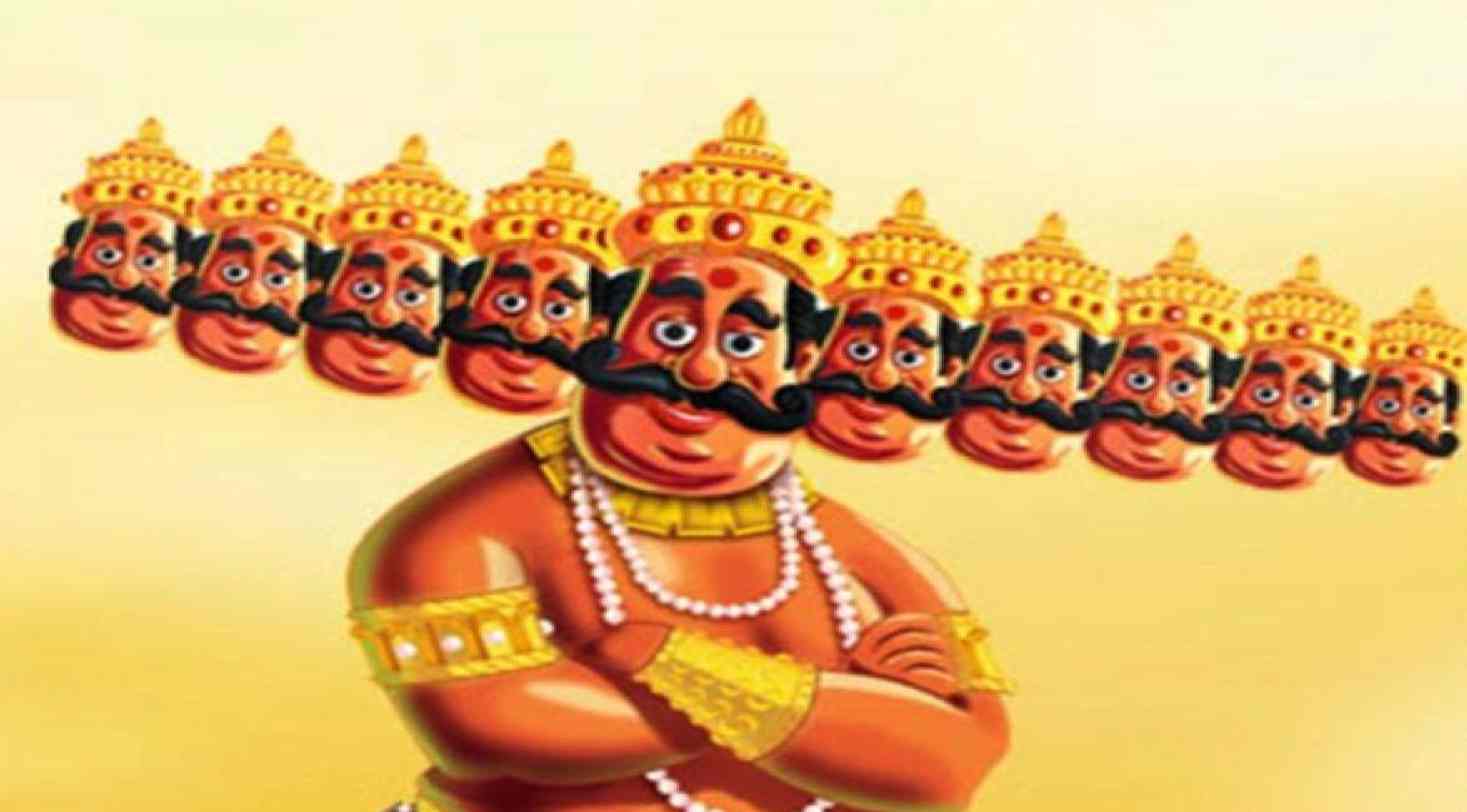
The story of Ravana, the roaring king of Lanka, is a captivating narrative filled with complex themes and profound lessons that have resonated with audiences for centuries. From his moral choices and unbridled ambition to his ultimate redemption, Ravana’s story offers a rich tapestry of insights into the human condition.
One of the key lessons derived from Ravana’s story is the challenge it presents to the notion of absolute morality. While Ravana is often portrayed as an antagonist due to his actions, his character possesses shades of complexity that invite us to question the binary nature of good and evil. The story teaches us the importance of understanding the complexity of morality and the need for introspection when assessing our own actions. It reminds us that human beings are capable of both noble and flawed actions, and that true understanding requires a nuanced perspective.
Ravana’s unquenchable ambition serves as a cautionary tale. Throughout the story, his insatiable desire for power and dominance blinds him to the consequences of his actions, ultimately leading to his downfall. Ravana’s narrative teaches us that unchecked ambition can corrupt the soul and have far-reaching negative consequences. It encourages us to evaluate our own ambitions, ensuring they are guided by ethics, empathy, and consideration for the well-being of others. By reflecting on Ravana’s story, we are reminded of the importance of tempering our ambitions with a sense of responsibility and moral integrity.
Central to Ravana’s character is his towering ego and pride. His inflated sense of self-importance leads to a disregard for the feelings and rights of others, and his refusal to heed warnings and advice ultimately seals his fate. Ravana’s story serves as a cautionary tale, reminding us of the dangers of ego and pride. It highlights the importance of humility and self-awareness in our own lives, urging us to recognize the limitations of our knowledge and abilities. By being humble and open to feedback and guidance, we can avoid the pitfalls of arrogance and become more receptive to personal growth and self-improvement.
Despite his heinous deeds, Ravana’s story offers a glimmer of hope through the power of redemption. In his final moments, Ravana experiences a moment of self-realization and surrenders to the divine will. This act of humility and repentance allows for the potential of redemption, reminding us that no one is beyond the possibility of change. Ravana’s story teaches us that true redemption is possible through sincere self-reflection, acceptance of responsibility, and the willingness to transform. It offers a profound lesson in the capacity for personal growth and transformation, no matter how deeply one has strayed from the path of righteousness.
Ravana’s narrative also serves as a reminder to cultivate empathy and compassion. While his actions are driven by selfish desires, his story prompts us to consider the circumstances and motivations that led him astray. It reminds us of the power of understanding and forgiveness, urging us to see beyond the surface and recognize the common humanity in others. By empathizing with Ravana’s struggles, we learn to bridge the divide between individuals and foster a more harmonious world. The story invites us to develop empathy and compassion as guiding principles in our interactions with others, leading to greater understanding and acceptance.
Furthermore, Ravana’s story emphasizes the importance of self-reflection and personal growth. It encourages us to examine our own actions, motivations, and desires, and to critically evaluate ourselves. By doing so, we can identify our own flaws and work towards personal transformation. Ravana’s journey reminds us that it is never too late to embark on a path of self-improvement and seek redemption for our past mistakes. It inspires us to continually question and challenge ourselves, to strive for moral and personal growth, and to learn from our experiences.
The story of Ravana is a profound narrative that offers a rich tapestry of lessons. It delves into the complexities of morality, ambition, and the transformative power of redemption. By exploring these themes, we gain a deeper understanding of our own actions, motivations, and potential for growth. Ravana’s story serves as a reminder that morality is multifaceted, ambition must be tempered, and redemption is within reach for those who seek it. By imbibing these lessons, we can navigate our own paths with greater wisdom, empathy, and a commitment to personal and moral growth.
Conclusion
In the realm of ancient legends and epic tales, few stories captivate the human imagination as profoundly as the saga of Ravana, the enigmatic king of Lanka. From the splendors of his kingdom to the depths of his complex character, from the clash of titans to the symbolism of his ten heads, the tale of Ravana is a tapestry woven with lessons that transcend time and resonate with the deepest corners of our souls.
Ravana’s kingdom, a marvel of opulence and grandeur, stands as a testament to the heights that human civilization can achieve. It is a realm where beauty and majesty intertwine, where art, culture, and innovation flourish under the visionary rule of a king driven by relentless ambition. Lanka, under Ravana’s reign, represents the potential within all of us to create greatness and build a legacy that withstands the test of time.
Delving deeper into Ravana’s character, we uncover a rich tapestry of complexities and motivations that challenge our preconceived notions of good and evil. Ravana was not a mere caricature of wickedness; he embodied the multidimensional nature of humanity itself. His flaws and virtues coexisted, rendering him a fascinating enigma. By understanding his complexities, we gain insight into the intricacies of human nature, reminding us that no individual can be reduced to a singular label or judgment.
Comparing Rama and Ravana, we witness a clash of titans that epitomizes the eternal struggle between light and darkness, virtue and vice. Rama, the embodiment of righteousness, and Ravana, the epitome of power and ambition, represent two opposing forces vying for supremacy. Their confrontation mirrors the internal battles we all face in our lives. It compels us to examine the choices we make and the consequences they carry, igniting a quest for self-discovery and self-mastery.
The myth surrounding Ravana’s ten heads reveals a profound symbolism that transcends its literal interpretation. Each head signifies a facet of his personality, representing the complexities and contradictions within ourselves. It reminds us that we are all multifaceted beings, capable of both noble acts and grievous mistakes. Ravana’s ten heads become a metaphorical mirror, prompting us to reflect upon our own inner demons and strive for balance and harmony within.
Rama’s exile and the abduction of Sita set the stage for a dramatic encounter that tests the limits of love, loyalty, and honor. The events leading to this fateful meeting underscore the fragility of human bonds and the consequences of our actions. They remind us that our choices ripple through the lives of others, and it is our responsibility to act with integrity, compassion, and empathy. In the face of adversity, we find the resilience to overcome challenges and emerge stronger, just as Rama did.
The battle between Rama and Ravana, a clash of celestial proportions, holds profound significance beyond the realm of mere mortal combat. It embodies the struggle between good and evil that permeates our existence, emphasizing the importance of standing up for righteousness and justice. The epic duel underscores the power of courage, determination, and unwavering faith, urging us to find the strength within ourselves to confront the darkness that lurks in our world.
In the aftermath of Ravana’s defeat and redemption, we witness the consequences of his actions and the transformative power of redemption. It teaches us that no matter how grave our mistakes are, there is always room for growth and change. Ravana’s journey serves as a reminder that we are not defined by our past, but by our ability to learn from it and strive for a better future. It compels us to embrace the path of forgiveness, both for others and ourselves, and to seek redemption with humility and genuine remorse.
Across literature and art, Ravana’s presence resonates in various cultural contexts, adapting and evolving with each retelling. From ancient scriptures to contemporary works, his character inspires artists and authors to explore the depths of human nature and the eternal struggle between good and evil. These depictions serve as a testament to the enduring power of storytelling, reminding us of the universality of the human experience and our collective thirst for wisdom and inspiration.
As we draw the curtain on the tale of Ravana, we are left with invaluable lessons that illuminate the path to a meaningful and purposeful life. Ravana’s story imparts timeless wisdom on morality, ambition, and the power of redemption. It teaches us to navigate the complexities of our own lives, to embrace our multidimensional nature, and embark on a journey of self-discovery and self-improvement.
Let us remember the splendors of Ravana’s kingdom, the intricacies of his character, the clash of titans, the symbolism of his ten heads, the dramatic events that led to his downfall, the significance of his defeat and redemption, and the profound impact he has had on literature and art. Above all, let us internalize the lessons embedded within this timeless tale and strive to embody the virtues of compassion, integrity, and resilience in our own lives.
As we venture forth, may the echoes of Ravana’s story inspire us to embrace our full potential, transcend our limitations, and forge a brighter future for ourselves and generations to come. Let the tale of Ravana be a guiding light, illuminating our paths with its timeless wisdom and reminding us that within the complexities of our own stories lies the power to create a world filled with compassion, justice, and enduring hope.
Top 13 Fascinating Facts About Lanka
Ravana’s kingdom, known as Lanka, was a land of opulence, adorned with magnificent palaces, splendid gardens, and intricate architectural wonders. The city of Lanka boasted advanced urban planning and infrastructure, including well-laid roads, reservoirs, and a sophisticated drainage system.
Ravana was a multifaceted character who possessed profound knowledge in various fields, such as music, warfare, and spirituality. Despite his flaws, Ravana displayed remarkable intelligence, bravery, and a strong sense of justice, making him a complex and intriguing figure.
Rama, the virtuous prince, symbolized righteousness and moral values, while Ravana embodied ambition, intellectual prowess, and a thirst for power. The clash between Rama and Ravana represents the eternal struggle between good and evil, raising questions about the complexity of human nature.
The ten heads of Ravana are often interpreted as a metaphor for his extensive knowledge, mastery of the six shastras (branches of learning), and his ability to process complex ideas simultaneously. They also symbolize Ravana’s arrogance and his constant desire to conquer and dominate.
Rama’s exile to the forest and the subsequent abduction of his wife, Sita, by Ravana, set the stage for a dramatic clash between the two legendary characters. These events highlight themes of loyalty, honor, and the lengths one would go to protect their loved ones.
The battle between Rama and Ravana showcases not only their extraordinary combat skills but also their contrasting ideologies. It symbolizes the triumph of good over evil, emphasizing the importance of righteousness and the consequences of one’s actions.
Despite his immense power and intellect, Ravana’s defeat at the hands of Rama emphasizes the consequences of his misguided actions. Ravana’s story also teaches us about the potential for redemption and personal growth, even for those who have fallen from grace.
Ravana’s character has inspired numerous literary works and artistic interpretations across different cultures, including literature, poetry, dance, and theater. These adaptations often explore the complexities of Ravana’s persona and provide unique insights into his motivations and psychological depths.
Ravana’s tale imparts valuable lessons on the consequences of moral ambiguity, unchecked ambition, and the pursuit of power without considering the well-being of others. It also emphasizes the importance of self-reflection, forgiveness, and personal transformation as key elements in the journey toward redemption.
Lanka, under Ravana’s rule, thrived as a vibrant hub of diverse cultures, where art, music, dance, and spirituality flourished. The kingdom attracted scholars, artists, and thinkers from various parts of the world, resulting in a rich tapestry of traditions and knowledge exchange.
Ravana’s intellectual prowess extended to his literary contributions, including writing treatises on music, composing hymns, and even penning a version of the Ramayana from his perspective. His literary works highlight his deep understanding of human emotions, philosophical insights, and poetic brilliance.
Ravana’s character continues to captivate modern audiences through various adaptations in literature, films, and theater productions. These reinterpretations often explore Ravana’s motivations, humanize his character, and offer alternative perspectives on his role in the epic narrative.
Ravana’s story raises thought-provoking questions about the nature of evil, the complexities of morality, and the blurred lines between heroism and villainy. The enduring fascination with Ravana’s character serves as a catalyst for deeper philosophical and ethical discussions in both scholarly and popular circles.


